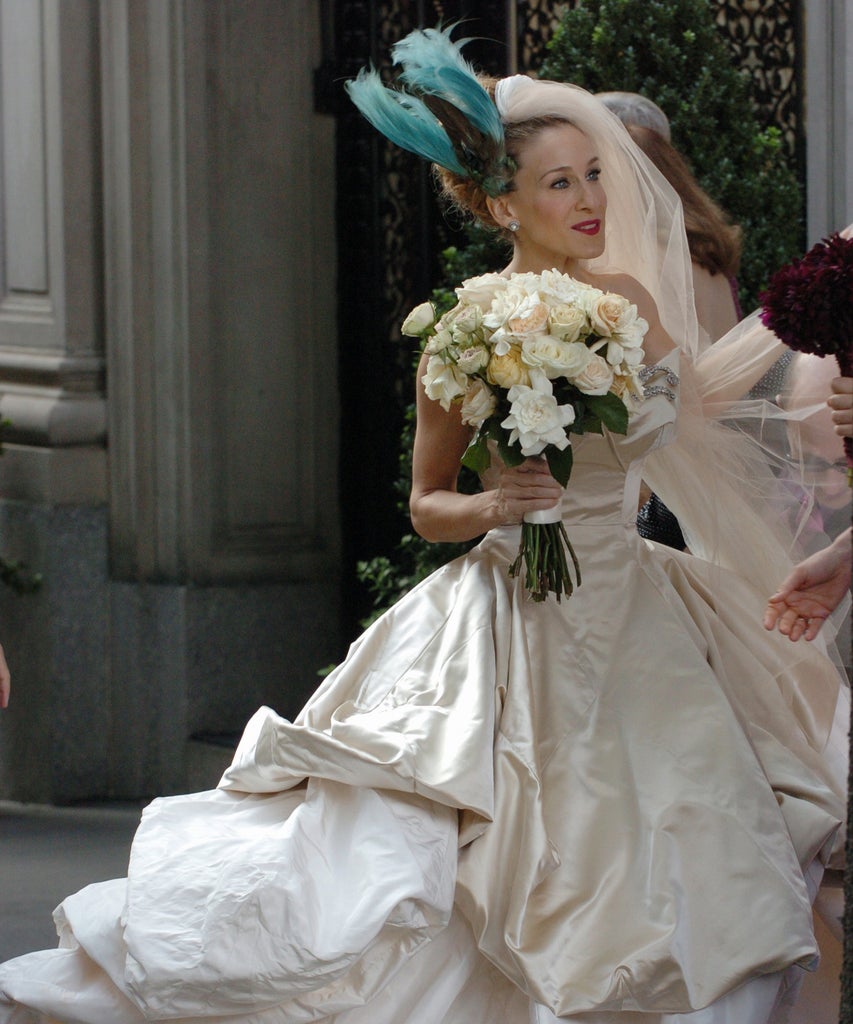
Roughly two million people get married in the U.S. every year, an occasion for which, prior to the pandemic, a good chunk of brides bought a new wedding dress. At the time, that purchase cost, on average, $1,600, according to The Knot.
But all that changed during COVID when most of 2020’s big weddings got canceled. As more couples opted for minimonies, the big, poofy gowns of yore were replaced with garments people had at home or more understated dresses or jumpsuits that felt appropriate for micro-weddings, which remain a popular option today. Another alternative that brides-to-be have turned to in the wake of the pandemic? Secondhand wedding dresses, which are not only cheaper but a more responsible alternative to gowns that often end up being worn only once.
According to global fashion shopping platform Lyst’s 2021 Wedding Report, searches for pre-owned wedding gowns are up 103% since March. In the same time frame, page views for vintage designer wedding pieces jumped 53%.
Natacha Blanchard, Consumer Lead at Vinted, a secondhand marketplace, noted a similar spike, with the number of used wedding gowns listed on the platform growing rapidly. “Vinted has seen more than 150,000 wedding dresses being listed for sale in the last year,” she tells Refinery29. Blanchard credits three things for why brides are choosing secondhand: price, choice, and sustainability.
Like with all other vintage wears, unless you’re trying to buy a rare piece from a popular designer, purchasing a secondhand wedding dress is going to come at a lower price than buying a new one. (In the last decade, according to ThredUp’s 2021 Resale Report, consumers saved $390 billion by buying secondhand as opposed to new.) Before you assume you can’t find the designer dress of your dreams secondhand, think again. On Vinted alone, there are over 20 used bridal gowns from Vera Wang. Yes, as in the designer behind both Ariana Grande‘s and Gwen Stefani’s wedding dresses.
The wide variety of options — from $20 no-name vintage frocks to $1,000 Vera Wang gowns (which, new, start at around $7,000 for the designer’s Luxe Collection) — is another reason that going the secondhand route is becoming more and more popular among brides. The choices are many, with luxury resale site Vestiaire Collective currently selling more than 4,000 wedding gowns from brands like Paco Rabanne, Pronovias, and Dior. Then there are specialty sites for buying and selling pre-owned and sample wedding dresses, like Nearly Newlywed. To compare options, big wedding stores, like David’s Bridal, often stock around 120 styles per store. All that said, unlike the selection at a place like David’s Bridal, where many of those 120-plus styles are available in sizes 0 to 30, every secondhand dress will only be available in a single size — and it might not be yours.
There’s also the fact that with the vast assortment of secondhand wedding dresses online comes the need to sort through a good deal of options. According to Blanchard, to simplify and speed up the process, it’s best to come into the search with a bridal dress style in mind. You can then personalize your search by size, price, style, or brand. She suggests reaching out to the seller once you find the dress for you and requesting detailed photos of the seams and threading to ensure that nothing is out of place or damaged. That, and she says to start the search early — that way, there is plenty of time to tailor the look to your body. The latter is important, as many of the brides who first owned these secondhand dresses had them customized to fit their own bodies. Because of that, Blanchard suggests you also ask the previous owner for precise measurements of the waist, hem, bust, etc. in addition to the tag size.
But the biggest reason why secondhand bridal looks have become so popular this year has to do with sustainability. According to James Reinhart, ThredUp’s Co-founder and CEO, the pandemic brought about “a radical transformation in retail.” During the last year-plus at home, having been surrounded by their purchases all day every day, consumers were confronted with their consumption habits. In turn, many began to consider new, more conscious ways of shopping, which include buying secondhand. According to ThredUp’s 2021 Resale Report, 33 million consumers bought used apparel for the first time last year, with 76% of those first-timers planning to increase their secondhand spending over the next five years.
Brides-to-be, consider this your “something borrowed.”
At Refinery29, we’re here to help you navigate this overwhelming world of stuff. All of our market picks are independently selected and curated by the editorial team. If you buy something we link to on our site, Refinery29 may earn commission.
Like what you see? How about some more R29 goodness, right here?
Secondhand Is Booming. Not Everyone Is Buying It
Powered by WPeMatico




